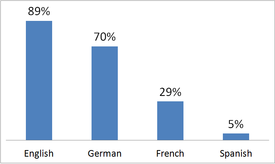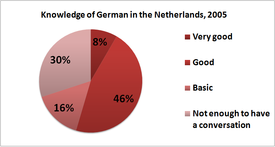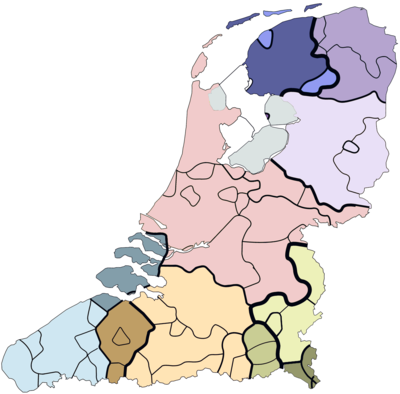Languages of the Netherlands
| Languages of Netherlands | |
|---|---|
| Official | Dutch[1] |
| Regional | Frisian (2.50%),[2] English (Caribbean Netherlands),[3] Papiamento (Bonaire);[3][4] Dutch Low Saxon (10.9%)[5] Limburgish (4.50%) |
| Minority | Yiddish, Romani[6] |
| Immigrant | See further: Immigration to the Netherlands |
| Foreign | English (90%-93%) (excluding the BES Islands) German (71%), French (29%), Portuguese (5%)[7] |
| Signed | Dutch Sign Language |
| Keyboard layout | |
| This article is a part of a series on |
| Dutch |
|---|
| Low Saxon dialects |
| West Low Franconian dialects |
| East Low Franconian dialects |


The predominant language of the Netherlands is Dutch, spoken and written by almost all people in the Netherlands. Dutch is also spoken and official in the Dutch Caribbean (Aruba, Curaçao, Sint Maarten and the Caribbean Netherlands special municipalities of Bonaire, Sint Eustatius, and Saba) as well as the Flemish Community of Belgium and Suriname. It is a West Germanic, Low Franconian language that originated in the Early Middle Ages (c. 470) and was standardised in the 16th century.
- West Frisian is a co-official language in the province of Friesland. West Frisian is spoken by 453,000 speakers.[9]
- English is an official language in the special municipalities of Saba and Sint Eustatius (BES Islands), as well as the autonomous states of Curaçao and Sint Maarten. It is widely spoken on Saba and Sint Eustatius. On Saba and St. Eustatius, the majority of the education is in English only, with some bilingual English-Dutch schools. 90-93% of the Dutch people can also speak English as a foreign language. (see also: English language in the Netherlands)
- Papiamento is an official language in the special municipality of Bonaire. It is also the native language in the autonomous states of Curaçao and Aruba.
- Several dialects of Dutch Low Saxon are spoken in much of the north-east of the country and are recognised as regional languages according to the European Charter for Regional or Minority Languages. Low Saxon is spoken by 1,798,000 speakers.[5]
- Another Low Franconian dialect is Limburgish, which is spoken in the south-eastern province of Limburg. Limburgish is spoken by 825,000 speakers. Though there are movements to have Limburgish recognised as an official language (meeting with varying amounts of success, having previously been recognised as a regional language) Limburgish consists of many differing dialects that share some common aspects, but are quite different.[10]
However, both Low Saxon and Limburgish spread across the Dutch-German border and belong to a common Dutch-German dialect continuum.
The Netherlands also has its separate Dutch Sign Language, called Nederlandse Gebarentaal (NGT). It has 17,500 users, and in 2021 received the status of recognised language.[11]
Between 90%[8] and 93%[12] of the total population are able to converse in English, 71% in German, 29% in French and 5% in Spanish.
Minority languages, regional languages and dialects in the Benelux
[edit]
The varieties in the Netherlands can be grouped into a major Low Franconian group, the one around Almere and the rest.[13] Limburg is divided into a small area around Weert, a large area until Venlo and an area North of this.[13] There is another major group: Low Saxon divided into three areas.[13] Urk is separate.[13] Friesland hosts many of the varieties obtained.[13] They can be divided into Frisian, archaic Frisian (Hindeloopen, Schiermonnikoog and Terschelling island), Friso-Franconian varieties (Frisian cities, Midsland, Ameland island and Het Bildt) and Friso-Saxon (in Stellingwerf and variously also Westerkwartier).[13] Possible clustering includes the following possible categories not mentioned hitherto: Zeeland and Central Gelderland.[13] Midsland, Ameland island and Het Bildt can be grouped together.[13] Leeuwarden and possibly Sneek can be grouped together. Dokkum, Stavoren, Kollum and possibly Heerenveen can have single varieties.[13]
West Frisian
[edit]West Frisian is an official language in the Dutch province of Friesland (Fryslân in West Frisian). The government of the Frisian province is bilingual. Since 1996 West Frisian has been recognised as an official minority language in the Netherlands under the European Charter for Regional or Minority Languages, although it had been recognised by the Dutch government as the second state language (tweede rijkstaal), with official status in Friesland, since the 1950s.[citation needed]
The mutual intelligibility in reading between Dutch and Frisian is limited. A cloze test in 2005 revealed native Dutch speakers understood 31.9% of a West Frisian newspaper, 66.4% of an Afrikaans newspaper and 97.1% of a Dutch newspaper.[14]
Low Saxon
[edit]- Northern Low Saxon
- Westphalian
- Midden-Drents
- Zuid-Drents
- Stellingwerfs
- Guelderish-Overijssels
- Twents
- Oost-Twents
- Vriezenveens (this is actually a separate dialect because of Westfalian influences)
- Twents-Graafschaps
- Veluws
- Oost-Veluws
- West-Veluws
Low Franconian
[edit]- Frisian mixed dialects
- Stadsfries
- Midlands
- Amelands
- Bildts
- Central Dutch
- West Frisian
- Mainland West Frisian
- Insular West Frisian
- Hollandic
- Kennemerlandic
- Zaans
- Waterlandic
- Amsterdams
- Strand-Hollands
- Haags
- Rotterdams
- Utrechts-Alblasserwaards
- Westhoeks
- Kleverlandish
- Rivierenlands
- Liemers
- Nijmeegs
- North Limburgian
- Central north Brabantian
- West Frisian
- Zeelandic-West Flemish (including French Flemish)
- Zeelandic
- Burger-Zeeuws
- Coastal West Flemish
- Continental West Flemish
- East Flemish
- Brabantian
- Northwest Brabantian
- East Brabantian
- Kempen Brabantian
- South Brabantian
- Limburgish
- West Limburgish
- Central Limburgish
- East Limburgish
Central Franconian
[edit]Ripuarian is not recognised as a regional language of the Netherlands.
References
[edit]Footnotes
[edit]- ^ rijksoverheid.nl nl#:~:text=Nederlands%20is%20de%20offici%C3%ABle%20taal,voor%20mensen%20die%20gebarentaal%20gebruiken. https://www.rijksoverheid.nl/onderwerpen/erkende-talen/erkende-talen-in nl#:~:text=Nederlands%20is%20de%20offici%C3%ABle%20taal,voor%20mensen%20die%20gebarentaal%20gebruiken. Retrieved 19 September 2023.
{{cite web}}: Check|url=value (help); Missing or empty|title=(help)[permanent dead link] - ^ "Regeling - Instellingsbesluit Consultatief Orgaan Fries 2010 - BWBR0027230". wetten.overheid.nl. Retrieved 23 August 2017.
- ^ a b "wetten.nl - Regeling - Invoeringswet openbare lichamen Bonaire, Sint Eustatius en Saba - BWBR0028063". Wetten.overheid.nl. Retrieved 23 August 2017.
- ^ "Regeling - Wet openbare lichamen Bonaire, Sint Eustatius en Saba - BWBR0028142". Wetten.overheid.nl. Retrieved 23 August 2017.
- ^ a b "Taal in Nederland .:. Nedersaksisch". taal.phileon.nl. Retrieved 23 August 2017.
- ^ "Minority languages in the Netherlands: Do you speak Lower Saxon?". 30 January 2012.
- ^ "EUROPEANS AND THEIR LANGUAGES" (PDF). 6 January 2016. Archived from the original (PDF) on 6 January 2016. Retrieved 23 August 2017.
- ^ a b "EUROPEANS AND THEIR LANGUAGES". Ec.europa.eu. Retrieved 2017-08-23.
- ^ "Taal in Nederland .:. Fries". taal.phileon.nl. Retrieved 23 August 2017.
- ^ "Taal in Nederland .:. Limburgs". taal.phileon.nl. Retrieved 23 August 2017.
- ^ Rapport "Meer dan een gebaar" en "actualisatie 1997-2001
- ^ ""English in the Netherlands: Functions, forms and attitudes" p. 316 and onwards" (PDF). Alisonedwardsdotcom.files.wordpress.com. Archived from the original (PDF) on 4 March 2016. Retrieved 23 August 2017.
- ^ a b c d e f g h i "To What Extent are Surnames Words? Comparing Geographic Patterns of Surname and Dialect Variation in the Netherlands".
- ^ Bezooijen, Renée van; Gooskens, Charlotte (2005). "How easy is it for speakers of Dutch to understand Frisian and Afrikaans, and why?" (PDF). Linguistics in the Netherlands. 22: 18, 21, 22.
- ^ "Gemeente Kerkrade - Kirchröadsj Plat". www.kerkrade.nl. Archived from the original on 21 February 2015. Retrieved 23 August 2017.
- ^ "Cittaslow Vaals: verrassend, veelzijdig, veelkleurig". Retrieved 9 September 2015. The PDF file can be accessed at the bottom of the page. The relevant citation is on the page 13: "De enige taal waarin Vaals echt te beschrijven en te bezingen valt is natuurlijk het Völser dialect. Dit dialect valt onder het zogenaamde Ripuarisch."
Notations
[edit]- "Taal in Nederland .:. Fries". taal.phileon.nl. Retrieved 23 August 2017.
- "Taal in Nederland .:. Nedersaksisch". taal.phileon.nl. Retrieved 23 August 2017.
- "Taal in Nederland .:. Limburgs". taal.phileon.nl. Retrieved 23 August 2017.
- Ginsburgh, Victor; Ignacio Ortuño-Ortin; Shlomo Weber (February 2005). "Why Do People Learn Foreign Languages?" (PDF). Université libre de Bruxelles. Archived from the original (PDF) on 2007-10-25. Retrieved 2007-10-10. - specifically, see Table 2.

